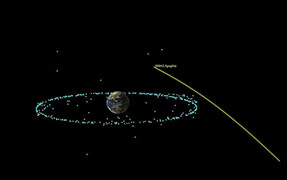Laser photoablation: a new biomedical tool
Most diseases and biological processes can only be studied in a living animal in which all the complex regulatory processes are occurring.1 New techniques using ultrashort laser pulses are increasingly allowing researchers to manipulate cells and tissue within living organisms to study normal and diseased functionality. The study of microstrokes may, in particular, benefit from these advances. These small strokes are thought to be caused by clots or bleeding in small blood vessels within the brain that lead to the death of neurons. Clinical studies have shown that such microstrokes are relatively common in the elderly and may play a major role in dementia and diseases such as Alzheimer's.2 However, no treatment is presently available, partly because reproducing microstroke lesions in animals has proved elusive. Ultrashort pulsed laser ablation provides a novel tool to produce such lesions, finally enabling the study of this disease.3
The technique has recently emerged as an excellent tool for the precision machining of solid state materials4–6 and has been used for the fabrication of waveguides7 inside transparent materials without affecting the surface. The extremely high light intensities achieved when focusing ultrashort laser pulses enable the nonlinear optical absorption of the laser light. The resulting ionized volume can be as small as the size of a diffraction-limited focus, typically ∼1μm3, and can be confined deep below the surface. This same technique can be applied to manipulating biological structures deep within a living organism.
To study the effect of microstrokes in the living brain, windows are made in the skulls of anesthetized rats and the blood vessels are labeled with an intravenous injection of fluorescent dye. We use another nonlinear optical technique, two-photon laser scanning microscopy, to image blood vessels and measure blood flow in the brain with microscopic resolution. To perturb microvessels located as deep as 500μm below the brain surface, laser pulses (800nm, 100fs, ∼0.01–5μJ) from an amplified titanium:sapphire laser are focused on the center of the target blood vessel.3 At the lowest energies, a train of pulses can be used to cause the vessel to leak blood into the surrounding brain tissue. Some blood proteins are neurotoxic and may cause microstrokes. Further irradiation of a leaky vessel can trigger natural clotting and block the vessel. Lack of blood flow is another route by which strokes can occur because neurons survive only a short time in the absence of blood flow. At the higher energy range, the target vessel is ruptured and bleeds into the surrounding brain tissue, forming a hemorrhage (see Figure 1). Similar hemorrhages appear to have been found in human patients.8

Using two-photon microscopy we observed that the blood flow in vessels close to and downstream from the clot was severely reduced. This is in stark contrast with results obtained for clotting arterioles (narrow blood vessels that branch art from arteries) on the surface of the brain, recently shown not to cause severe blood flow reductions.9 Our result may appear counterintuitive because surface arterioles, being much larger than deep microvessels, would lead one to expect their clotting to have a greater effect on the blood than a clot in a fine subsurface vessel. But if we consider that surface arteriole networks have loops that protect against blood flow decreases due to single-vessel clots, our result become understandable.
We also investigated therapeutic strategies—such as lowering blood viscosity—to allay the effects of microstrokes. To reduce the effective blood viscosity, we intravenously injected a rat with a large amount of saline after induction of a microvessel clot, essentially diluting the blood in order to make it flow more easily. Blood flow as close as two branches away from the clot showed substantial recovery after treatment, which suggests that drugs that manipulate blood viscosity might be useful in treating patients.
Ultrashort pulsed laser ablation thus represents a tool with sufficiently fine spatial resolution to selectively target cells and structures of interest. Since it can be used in live animals, it has great potential for the study of diseases such as microstrokes and other biological phenomena. The usefulness of microscopic manipulation in whole animals has also been demonstrated in neuroscience studies in which neuronal processes were severed to study their effect on behavior.10,11 Such applications demonstrate that there are many opportunities for advanced optical technologies to contribute in many areas of biology.



